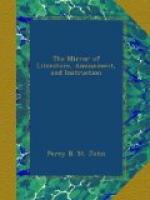This walk, as it approaches the water, leads into a darker shade, and descending some steps, placed to give a picturesque appearance to the bank, you enter a kind of cave, with a dripping rill, which falls into the water below, whose bank is broken by thorns, and hazels, and poplars, among darker shrubs. Here an urn appears with the following inscription:—“M.S. Henrici Bowles, qui ad Calpen, febre ibi exitiali grassante, publice missus, ipse miserrime periit—1804. Fratri posuit.”—Passing round the water, you come to an arched walk of hazels, which leads to the green in front of the house, where, dipping a small slope, the path passes near an old and ivied elm. As this seat looks on the magnificent line of Bowood park and plantations, the obvious thought could not be well avoided:
“When in thy sight another’s
vast domain
Spreads its dark sweep of woods, dost
thou complain?
Nay! rather thank the God who placed thy
state
Above the lowly, but beneath the great;
And still his name with gratitude revere,
Who bless’d the sabbath of thy leisure
here.”
The walk leads round a plantation of shrubs, to the bottom of the lawn, from whence is seen a fountain, between a laurel arch; and through a dark passage a gray sun-dial appears among beds of flowers, opposite the fountain.
The sun-dial, a small, antique, twisted column, gray with age, was probably the dial of the abbot of Malmesbury, and counted his hours when at the adjoining lodge; for it was taken from the garden of the farm-house, which had originally been the summer retirement of this mitred lord. It has the appearance of being monastic, but a more ornate capital has been added, the plate on which bears the date of 1688. I must again venture to give the appropriate inscription:—
“To count the brief and unreturning
hours,
This Sun-Dial was placed among the flowers,
Which came forth in their beauty—smiled
and died,
Blooming and withering round its ancient
side.
Mortal, thy day is passing—see
that flower,
And think upon the Shadow and the Hour!”
The whole of the small green slope is here dotted with beds of flowers; a step, into some rock-work, leads to a kind of hermit’s oratory, with crucifix and stained glass, built to receive the shattered fragments, as their last asylum, of the pillars of Stanly Abbey.
The dripping water passes through the rock-work into a large shell, the gift of a valued friend, the author of “The Pleasures of Memory;” and I add, with less hesitation, the inscription, because it was furnished by the author of “The Pains of Memory,” a poem, in its kind, of the most exquisite harmony and fancy, though the author has long left the bowers of the muses, and the harp of music, for the severe professional duties of the bar. I have some pride in mentioning the name of Peregrine Bingham, being a near relation, as well as rising in character and fame at the bar. The verses will speak for themselves, and are not unworthy his muse whose poem suggested the comparisons. The inscription is placed over the large Indian shell:—




